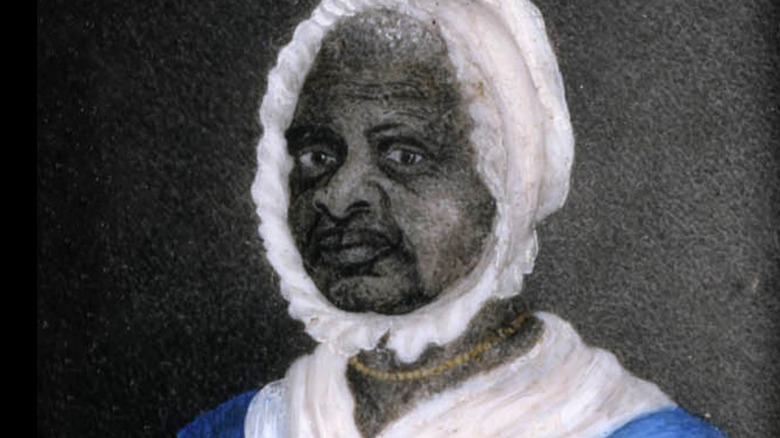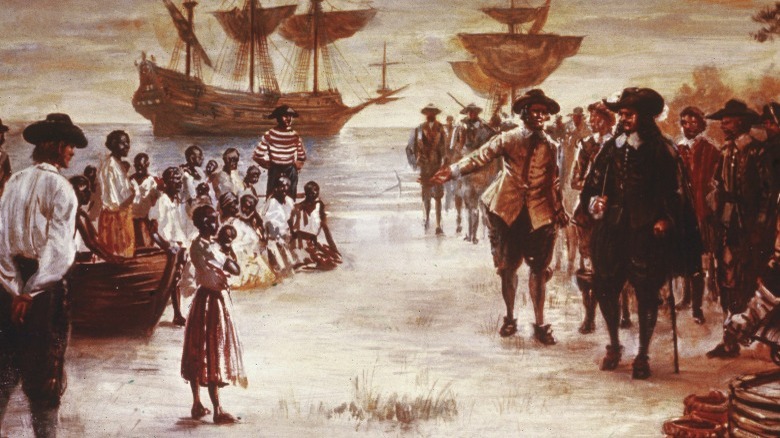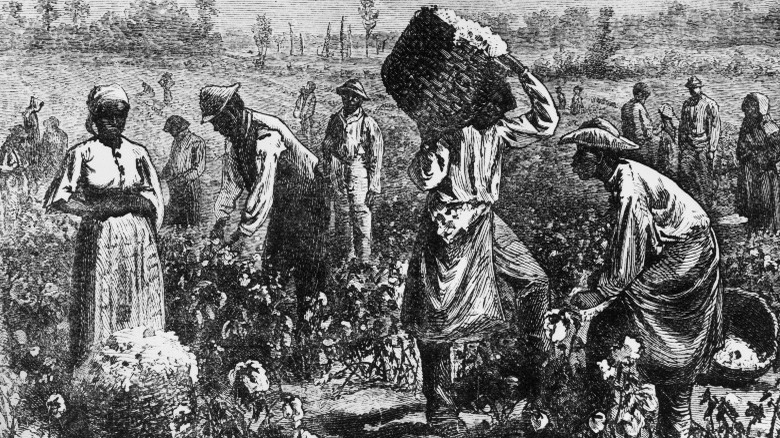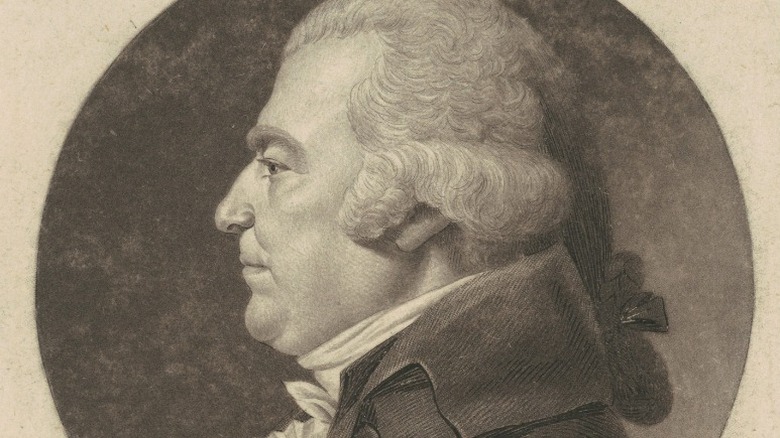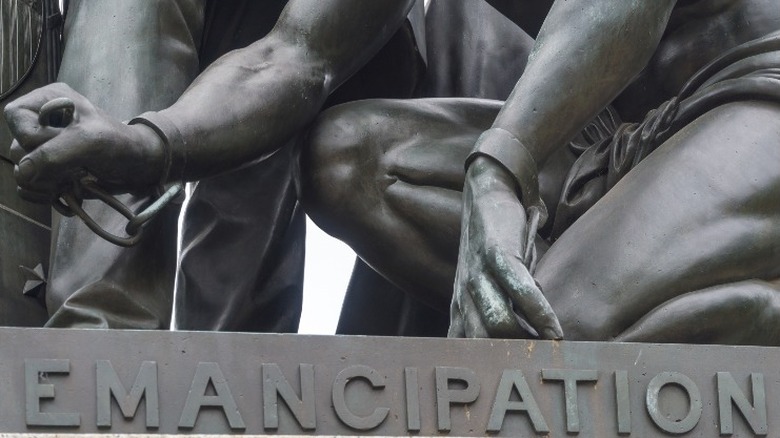How Mary Freeman's Escape Helped End Slavery In Massachusetts
The history of slavery in the United States is a complex and sensitive issue that has been subject to controversy since before the establishment of the country. As a nation founded on principles such as liberty, freedom, and equality (per the Bill of Rights Institute), it is highly contradictory to then turn around and enslave an entire group of people to help build that nation. The conundrum of this contradiction did not go completely unnoticed, as America also has a history of the enslaved bringing lawsuits in order to procure their freedom.
Fairly early on in United States history, there were legal cases focusing on the issues of enslaved African-Americans. Some of the more prominent cases include Rachel v. Walker (via Genesee History), Dred Scott v. Sanford (per the National Archives), and Quock Walker v. Jennison (via Encyclopedia.com). While it was a major challenge to even get these cases heard in court, there were some that were ultimately successful. One of the earliest cases that began to change the game regarding enslavement was that of Elizabeth "Mum Bett" Freeman, in Brom and Bett v. Ashley.
Early life
As she was born into slavery, the details surrounding the early years of Elizabeth Freeman's life are not well known. According to Biography, she is believed to have been born around 1742, though the location and exact date of her birth are unknown. Other sources, like Women and the American Story (WAMS) at the New-York Historical Society, put her date of birth in 1744, in a small unnamed town in New York.
She was reportedly owned by a man named Peter Hogeboom, who had ties to the Dutch settlers who originally settled the area. It was also Hogeboom and his family who gave her the nickname Bett. She and her younger sister were eventually sent to live with one of Hogeboom's daughters, named Hannah, who was married to John Ashley. Ashley was a prominent figure in the State of Massachusetts, as he was a war hero, landowner, colonial legislative representative, and local judge (per WAMS). But life in the home of such an influential man was not always easy.
The life of the enslaved
According to History, the legacy of the trade in enslaved people in the colonies can be traced back to the year 1619. A privateer known as The White Lion is credited with bringing a group of 20 enslaved Africans to Jamestown, Virginia. The American colonies realized that the labor provided by these enslaved people was cheaper and more abundant, therefore it became common practice. The institution of slavery became extremely important to the economy in the southern colonies like Virginia and Georgia, while the more northern regions were less dependent on it.
No matter the year or the place in the colonies, life as an enslaved individual was difficult, laborious, and traumatizing. This was also true for Bett. Her owners, the Ashleys, were well-known figures in their community, and had great wealth. Much of that wealth, however, was built on the backs of those they enslaved, like Bett. Alongside her sister, Bett served the Ashley household by taking care of their children, cooking, cleaning, and maintaining their garden (per Women and the American Story).
The moment that changed everything
John Ashley reportedly had a pretty even temper when dealing with those of his household who were enslaved, which was not always the case among other owners. His wife, Hannah, however, did not. She had quite a reputation for being extremely cruel and unable to control her anger (per WAMS).
One day, Hannah Ashley's anger got the better of her, and she attempted to take her frustrations out on an enslaved girl, named Lizzie. It is believed that Lizzie was somehow related to Freeman — either her sister or her daughter. Mrs. Ashley attempted to strike Lizzie with a hot shovel and Freeman intervened, taking the brunt of the impact herself. The shovel sliced through Freeman's arm, all the way down to the bone. Though the wound did eventually heal, Freeman bore the scar from that assault for the rest of her life.
This violation was a turning point in Freeman's life. Following her injury, Freeman fled the Ashley property and sought the help of a man named Theodore Sedgwick (per Biography). Though fear may have played a role in her decision to run away, she also had another motivation.
Brom and Bett v. Ashley
John Ashley was an influential figure in his community and a supporter of the growing movement toward a revolution. While working in his home, Freeman overheard discussions between Ashley and other prominent residents who were fed up with British rule. It has been speculated that hearing this kind of talk may have inspired Bett to embark on her own pursuit of freedom (per History).
Bett connected with Sedgwick in 1781 when John Ashley tried to reclaim her and another enslaved man, named Brom, as his "property." According to Mass.Gov, Brom also joined the case, which found both of them challenging the legality of slavery in the state of Massachusetts. The argument focused on the fact that they believed the newly drafted Massachusetts Constitution had outlawed slavery. In August of 1781, Sedgwick brought this case before the County Court of Common Pleas, and the court found in favor of both Brom and Bett. Not only did they declare that Brom and Bett were not Ashley's property, they also awarded them 30 shillings in damages. Initially, Ashley attempted to appeal the verdict, but later dropped the case.
A historic legacy
After the Brom and Bett case, there were additional court cases filed addressing the injustice of the institution of slavery. According to Freedom's Way, Prince Hall, a Revolutionary-era abolitionist and free African-American, mounted legal challenges regarding slavery in Massachusetts. The case of Quok Walker eventually helped bring the trade in enslaved people to an end in the state. This made Massachusetts one of the first states to abolish this practice.
After winning her case, Bett changed her name to Elizabeth Freeman, and with her new-found freedom she worked as a paid servant in the home of her lawyer, Theodore Sedgwick (per Biography). She went on to build her own home and raise her own family. Freeman passed away around the age of 85, on December 28, 1829. After her death she was buried on the Sedgwick family plot, as she had become a beloved member of their family. By some accounts, one of her descendants was W.E.B. Dubois, who became a highly influential African-American rights activist who earned his Ph.D. at Harvard in 1895, making him the first African-American to do so. He was also a co-founder of the National Association for the Advancement of Colored People. Because of her successful lawsuit and dedication to the pursuit of freedom, Elizabeth Freeman helped to pave the way for the eventual emancipation of all enslaved people in America.
